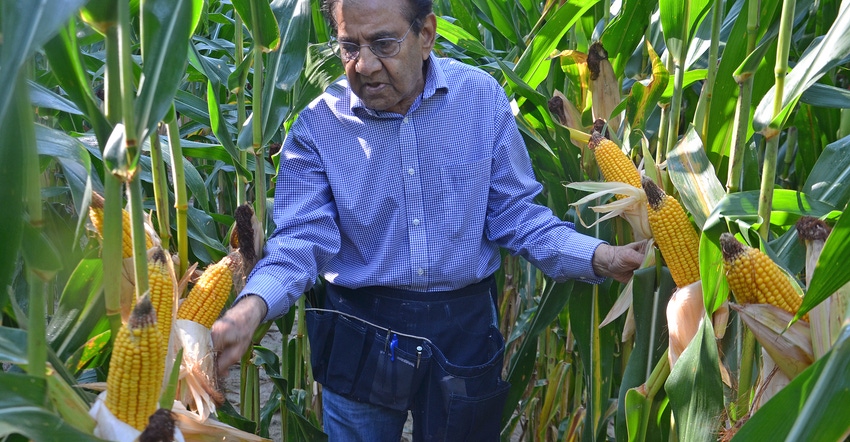
The Corn Watch ’20 field fared better than many other fields in Indiana, Illinois and Iowa in terms of receiving timely rains. However, it didn’t take Dave Nanda long to conclude that more moisture and less heat still would have helped hybrids in this field.
“When we pulled back husks and exposed ear tips, too many of them showed evidence of aborted kernels,” says Nanda, director of genetics for Seed Genetics Direct, sponsor of the Corn Watch ’20 project. “When you find 1 to 2 inches of blank cob, and evidence that there were kernels which aborted, you suspect that weather conditions were a factor.”
Genetics can play a role in whether there is typically any blank cob at the tip of ears, Nanda acknowledges. Some hybrids, especially in the past, sometimes left a small amount of empty cob even under normal circumstances.
“When you find it on both hybrids [planted in the same field], which I did, and find 1 to 2 inches of blank cob on the tips of most ears, then you know something else is going on besides genetics,” Nanda explains. “There are other factors that can cause stress which leads to kernel abortion. But dry weather at the wrong time when the plant is making critical decisions is often the leading factor.”
Yield impact
How much yield can you lose to kernel abortion caused by environmental stress? Nanda says this a math problem. More kernels per acre mean more bushels per acre. If you subtract kernels from each row of ears, then you’re taking away yield — perhaps at a faster pace than you might think.
Here’s an example to illustrate how much tip abortion and blank cobs at the tips of ears can affect yields. It’s based on what Nanda found while inspecting fields before harvest.
Suppose there are 30,000 ears per acre, with 16 rows of kernels per ear and only 32 kernels per row. “The cob was there to support more kernels, but they aborted,” Nanda says. “Remember that corn plants don’t care about your pocketbook. Their goal is to make healthy progeny. Plants believe they are making babies to continue their species. So, if it turns dry when decisions about kernel number per row are being made, plants will abort tip kernels to make sure they can properly fill remaining kernels and have viable progeny.”
In this field, kernel depth and kernel size were still average or above average. So, Nanda elected to use 85 as his division factor in the corn yield estimate formula, representing a volume of 85,000 kernels per bushel. You can find the complete formula in the Purdue University Corn & Soybean Field Guide.
Based on 1/1,000 of an acre, the formula is 30 ears times 16 rows times 32 kernels per row, divided by 85. That calculates out to 180 bushels per acre.
Now suppose there was less drought stress, with 37 kernels per row on each year. With just five extra kernels per row, yield jumps to 209 bushels per acre.
“There was easily room for 42 kernels per row on some of these cobs,” Nanda says. “It just didn’t happen.”
At 42 kernels per row, 16 rows per ear and 30 ears per 1/1,000 acre, that’s 237 bushels per acre.
That’s a difference of 57 bushels per acre, jumping from 32 to 42 kernels per row.
About the Author(s)
You May Also Like




